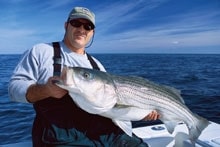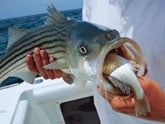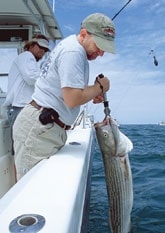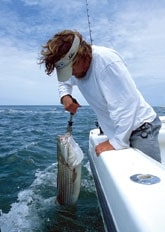
I was standing in the back of my friend Stan Gold’s 24-foot walkaround, Blind Date, when I felt my braided line vibrate nervously. Then a violent tug followed, and my line went tight. I fed line through the rod guides while slowly counting to myself. One, two, three¿The line steadily disappeared from my reel. Four, five, six…The striper took my croaker, turned it around and swallowed it. Seven, eight, nine…I flipped the reel into gear. Ten! I lifted the rod tip, cranked the line tight and jammed the rod butt into my gut.
My rod bent over as the fish began its run. Gold kicked the boat into gear and pulled us away from the rocks while my friend Kevin Whitley cranked in his croaker and got the net ready. The fish continued to take line, heading straight for the rocks. Would the fish break me off? Throw the bait? Pull the hook? I thought. When live baiting, the fish isn’t caught until it hits the deck. My stomach did flips as we fought back and forth. Finally, a fat striped bass appeared off the stern with the whole croaker dangling from its mouth and my circle hook set solidly in its jaw. I gave the reel handle a couple more turns, and Whitley slid the net under the fish. The striper hit the deck with a thud that was almost as loud as my heartbeat.
LIVEN IT UP

| |A small striper with more than a mouthful of croaker.|
Nothing makes a big striped bass happier than a fat, juicy croaker tumbling helplessly in the current, and nothing makes an angler happier than a fat, juicy striper on the end of his line.
In the spring, there are a lot of happy anglers in the lower Chesapeake. Migrating stripers that have spent the spring spawning in the upper Bay head out to the ocean where they will spend the summer. On their way, they pass the 17-mile-long Chesapeake Bay Bridge-Tunnel (CBBT), and every striped bass that leaves the Chesapeake must swim under – or over – this roadway. That’s a lot of fish passing a lot of structure in a short period of time.
The first step in live-baiting stripers is finding the live bait. Spring is a season of plenty in the lower Chesapeake, and there is usually plenty of bait around if you know where to look.
Croaker are the most plentiful baitfish. These gullible critters can be caught by drifting through areas with hard bottom, such as the rock islands of the CBBT or in the deep waters of the Baltimore or Thimble Shoal Channel. Gold, Whitley and I caught our croaker at the mouth of Little Creek Inlet.
To catch bait, I use a two-hook bottom rig sweetened with a slice of squid, a chunk of bloodworm or a sliver of Fish Bites. I tie my own bottom rigs out of 30-pound monofilament. Starting with a four-foot section of leader material, I tie a three-inch surgeon’s loop in the end for the sinker, then make two more loops about six inches apart for each No. 1 long-shank hook. I tie another loop on the top of the rig to connect it to the snap swivel tied to the line. I use this rig with a medium-action baitcasting rod and reel. Depending on water depth, I use between two and six ounces of sinker to hold bottom.
After a half-dozen drifts across the channel we had a couple of dozen baits in the live well.
RIG UP

| |Skipper Stan Gold boats another live-bait-caught striper taken on the south side of the Baltimore Channel.|
Gold fired up the boat, and we shot across the Bay toward Third Island of the CBBT.
The “islands” are man-made rock islands that surround each end of the bridge’s two tunnels. Local anglers count the islands from the south, so Third Island is on the south side of the Baltimore Channel. All the islands hold stripers and can be fished using live bait. We chose Third because it was on our way to the Inner Middle Ground Shoal where we planned to fish for cobia and drum later in the day.
When we arrived, Gold pulled the boat around to the spine where the tunnel dives below the water. The tide was ripping out and there were a couple of boats drifting over the tube. One of the boats had an angler in the cockpit fighting a nice fish. We watched him work the fish to the boat, and when he pulled a fat striper over the gunwale, the three of us jumped into action.
It only took us a minute to tie up our live-bait rigs. We each grabbed a medium-heavy outfit spooled with 60-pound-test braided line from the quiver of rods sticking out of Blind Date’s rocket launcher. I threaded a fishfinder sleeve followed by a plastic bead onto my line then tied on a 75-pound-test snap swivel. Next, I snelled an 8/0 circle hook to four feet of 80-pound-test leader material. I made a surgeon’s loop at the end of the leader and attached it to the snap swivel. Finally, I tied an inline trolling sinker to the fishfinder sleeve with a piece of 20-pound-test monofilament.
I always start with a two-ounce sinker and move up to a heavier weight as the current increases. A low-profile trolling sinker works best to avoid getting hung up in the rocks. If the sinker gets snagged, the loop of mono holding it to the fishfinder sleeve will break off without sacrificing the whole rig.
Once I rigged up, I opened the live well and netted an eight-inch croaker. I pushed the circle hook through the fish’s nose and got ready to drop it into the rocks.
THIRD ISLAND’S A CHARM

| |Many striper anglers are now opting for circle hooks when fishing live bait to help prevent gut-hooked fish. |
Gold pulled Blind Date uptide of the tube. The current ripped over the underwater structure, pushing up a line of standing waves along the spine. We were about 100 yards from where the tip of the island drops into the water between Third Island and the Number 13 green can buoy. The depthfinder showed the water to be 50 feet deep on the edge of the tube.
Gold took the boat out of gear, and we dropped our rigs into the water. We each fed line off of our reels while our sinkers pulled our croakers toward the rocks. As we passed over the tunnel and through the rip, the depthfinder jumped up to 25 feet on the spine of the tube. Just on the other side of the rip, the bottom dropped off, and the finder showed a blob of fish hanging in the eddy downcurrent of the tunnel.
That’s when I felt my braided line vibrating, indicating a nervous croaker. I felt a solid tug and a big fish pulling line from the reel. I flipped the reel in gear and cranked in the loose line. My rod tip dipped heavily and then popped up. I had jumped the gun: The fish was gone.
| If You Go To Book a Trip Jeanie Lee Charters Dale Carlson (757) 496-9192Pretty Work Charters Herb Gordon (757) 464-3974Paige II Charters Craig Paige (757) 672-9381Fincatcher Ryan Overton (757) 679-3474Weekend Honeymoon II Tim Capoldo (757) 646-3785 |
When I reeled in the croaker, its scales were sucked off and its fins were tattered. I cursed myself – to the immense pleasure of my fellow anglers – for pulling the bait from the hungry striper’s mouth.
For the rest of the tide, every drift over the tube resulted in a striper on the deck or a live bait returned quite a bit the worse for wear.
As more boats showed up, we would get in line to make our drift, following the boat ahead of us through the rip. Eventually, the pass got crowded, so Gold moved closer to the rocks. Drifting through the rip, in less than 15 feet of water, we hooked our biggest fish of the day – a 41-inch spring giant.
We put a limit of stripers in the box, released at least as many back to the Bay and got the thrill of feeding live baits to voracious stripers.
NAVIGATING THE CBBT
Finding the bridge’s landmarks is the first step in knowing where to fish. Starting from the south end of the Chesapeake Bay Bridge-Tunnel and heading north, boaters will pass the first and second Small Boat Channels marked by green and red lights hanging from the bridge. Next stop is the Yancy Wreck, where a ship collided with the bridge and knocked out a section of the roadway. First Island is the first rock island on the south end of the Thimble Shoal Channel Tunnel. Second Island is on the other side of the tunnel. Farther down the bridge is the Bend where the bridge turns northeast. Then comes Third Island on the south side of the Baltimore Channel. Captains should note Rogue Rock, a boulder knocked out of place by a barge that sticks up on the spine of the tunnel about 75 feet north of Third Island. On the other side of the Baltimore Channel is Fourth Island. Just north of the Fourth Island is the 12 Mile Marker identified by a small green sign on the bridge directly over the south edge of Nine Foot Shoal. After the shoal, is the High Rise, where the bridge rises 75 feet over the North Channel before terminating on Fisherman’s Island.
AN EYE ON THE BAY
Many striped bass caught in the Chesapeake Bay are infected with a disease called Mycobacteriosis. According to a study by the Virginia Institute of Marine Science, more than 75 percent of the stripers tested carried the disease, but only 20 to 30 percent of these fish showed external signs of infection such as ulcers, sores and lesions. Other fish will have gray nodules in the spleen and kidney when they are cleaned. There is a slight potential that the disease can be passed on to humans, so anglers should handle fish sparingly. VIMS recommends that anglers wear gloves when handling stripers. The bacteria cannot survive temperatures above 170 degrees Fahrenheit, so cooked striped bass is safe (for more information, visit www.vims.edu). Some of the Bay stripers may be beat up, but they’re still fun to catch. – Ric Burnley









